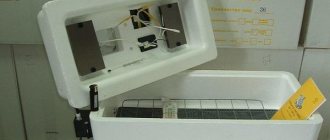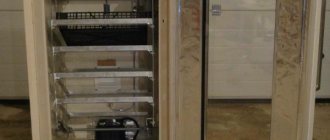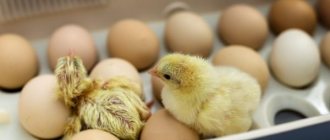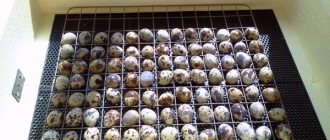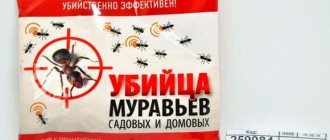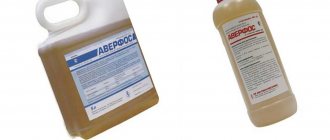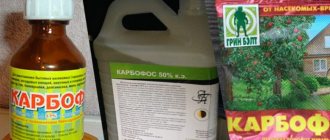Home » Articles about egg incubators » Operation of the Cinderella incubator
The first Cinderella incubator appeared on the market in 1998. Developer and manufacturer – OLSA-Service company (Novosibirsk). To date, 24 series of devices have been developed. The body is made of durable yellow polystyrene foam. The Cinderella incubator is operated in accordance with the instructions supplied with each model.
Advantages of Cinderella incubators
The company offers equipment:
- automatic (for 28, 70, 98 eggs);
- mechanical (for 70 eggs);
- manual (for 45, 100 eggs).
Related products are available: grills for quail eggs, electronic temperature/humidity meters, thermostats, ovoscopes. Advantages of incubators of this brand:
- high percentage of hatchability;
- automatic transition from power supply to battery in case of power outage;
- the ability to continue incubation using hot water;
- high reliability of the rotating device and smooth operation (rotation - up to 10 times a day);
- maximum proximity of the artificial incubation mode to the natural incubation process;
- the possibility of hatching eggs not only from chickens, but also from other birds (geese, ducks, quails);
- low weight of the structure (up to 5 kg).
Products are protected by patents and certified. In the Cinderella incubator, temperature and humidity are controlled by high-precision sensors. Thanks to the patented heating system, heat is evenly distributed.
The water tray is made of durable plastic. Thanks to the side grid system, you can add water without removing the trays. The devices are equipped with 1-6 egg racks. The incubators operate from the mains (220 V). An additional option is to connect a 12 V battery.
There are few disadvantages to Cinderella incubators:
- For some models, the temperature sensor does not work correctly and requires replacement (the device must be tested before the first boot);
- The housing needs to be thoroughly disinfected after use (the material is porous).
Advantages and disadvantages
The main advantages of the Cinderella incubator:
- pros
- High efficiency indicators - the device ensures the survival rate of chicks by 95%, which no known analogue can boast of.
- Mobility - the heaviest device weighs 5 kg, which allows it to be transported to any point without much energy consumption.
- Possibility of maintaining the microclimate inside the device even during a power outage for up to 10 hours.
- Automation of biomaterial turning over.
- Possibility of additionally equipping incubators with grids for goose, duck and quail eggs.
- Full control over the process.
- Automated transition to power reserve.
- Economical energy consumption.
The device can be used not only by experienced poultry farmers, but also by beginning farmers.
- Minuses
- The need to set the temperature yourself due to the fact that the process is not fully automated.
- The foam casing is not durable and does not allow air to pass through well. Without proper disinfection measures, mold develops in the pores.
Important! The design of the incubator involves automatic and manual turning. Be sure to check the position of the biomaterial and the thermostat. They may shift during movement.
User manual
Features of incubation in the Cinderella incubator depend on:
- characteristics of the model (manual, automatic, mechanical);
- type of poultry being hatched (incubation modes for chickens, ducks, and quails are different).
General recommendations for all models:
- When purchasing an incubator, you need to check the completeness;
- assembly is carried out strictly according to the instructions supplied with the specific model;
- the device must be installed on a flat horizontal surface in a room where there is a constant flow of fresh air (without drafts) and the temperature is within +15...+25°C;
- Do not expose the device to direct sunlight or place it near heaters or fire sources.
What is raising chickens at home?
A bird that has lived next to humans for many centuries, serving as decoration or providing meat and egg products, is the chicken. Science has developed many selections and varieties, but modern crosses have a weak maternal instinct.
As a result, it becomes more difficult for all bird breeders to manage their craft without high-quality equipment to compensate for the lack of a brood hen.
Digital technologies can provide conditions for hatching chicks that are close to the standard. And also enable the poultry farmer to control the process and get more high-quality young animals.
The method of raising poultry by artificial “brooding” is a progressive and productive method not only for private backyard farming; it is widely applicable in agriculture. For this reason, the industry has chosen hatchery breeding as its main focus.
Test run
To check functionality:
- baths are filled with warm water;
- the lid is closed;
- 500 ml of hot water is poured into the heaters through the holes, the caps are screwed on;
- The temperature sensor with a thermometer is installed so that the wire is positioned vertically.
The incubator is plugged in and the desired temperature is set using a thermostat (+39°C). Once it is reached, the indicator goes out. After some time, it should turn on again, signaling the operation of the heaters that compensate for cooling. The operation of the device is checked for 2-3 hours.
Temperature accuracy is monitored using an alternative thermometer with a good level of accuracy. After completing the test, turn off the device and drain the water.
Reviews
To accurately understand all the pros and cons of this model, it is worth considering customer reviews.
| Positive | Negative |
| Light weight | Not very reliable |
| Can be placed in any convenient place | The need for grating control |
| Ease of use | The need to constantly look at the thermometer |
| Battery operation allowed | Mold formation on the walls |
| Low cost | Inaccurate operation of electronics |
| Excellent temperature distribution | |
| Ability to maintain the required level of humidity | |
| Automatic rotation capability | |
| Possibility of heating with hot water | |
| Excellent output up to 98 percent |
Egg laying and incubation
After checking the device, you can begin laying the eggs for the first time. They must be fresh, fertilized, checked visually and using an ovoscope.
The incubation material is stored at a temperature of no more than +15°C. On both sides, each specimen is marked with different symbols so that you can control the correct rotation. An automatic rotating device is attached to the body (the rotation will be very smooth).
If manual devices are used, the first turn should be made no later than 8 hours after laying. The procedure is stopped 2 days before withdrawal.
Warm water is poured into plastic trays, filling the cells symmetrically on one side and the other. The number of cells to fill depends on the level of humidity in the room (at a high level, pour water into 2 cells on opposite sides, at a low level, fill all 8, at an average level, choose an intermediate amount).
Plastic grids are laid out on pallets. Install an iron grate. The pin is connected to the pusher hole. Eggs are loaded into the incubator. When laying, make sure that all copies are laid out the same way (the same type of symbol serves as a guide).
Close the lid, pour water heated to a temperature of 80-90°C into the heaters (1 liter into each). The temperature sensor is fixed vertically, the humidity sensor is placed arbitrarily. The rotary device is connected to the network, and after 30 minutes the incubator itself is turned on. The temperature regime is set in accordance with the type of bird being hatched. During operation of the device, monitor temperature/humidity indicators and add water if necessary. The iron bars are removed 2 days before hatching.
Incubation process
Cinderella incubators are used for hatching chicks, ducklings, goslings, turkey poults and quails. Basically, laying eggs is carried out in one step. Incubation in Cinderella in terms of timing, humidity and temperature requirements depends on the type and breed of poultry.
Failure to comply with the temperature regime can lead to the death of the entire brood: in hot and dry air the embryo will die from lack of water, and in cold air it will freeze. To ensure that the incubation process is not interrupted during power outages, it is recommended to install an additional battery. And while operating from backup power, the ventilation holes in the device are closed. If there is no electricity for more than 1.5 hours, then the cooled water is drained from the heating elements and boiling water is added. It is recommended to drain the water using a special tube without removing the lid.
Maintaining the required humidity parameters is especially important in the first days, when the embryos develop the main organs.
For all types of poultry, humidity rises to maximum levels in the last incubation days. This makes the shell softer and easier to peck. In humid air, the chicks warm up and dry out faster.
Another important point: frequency of grate rotation and uniform heating. This process is necessary to prevent the embryos from sticking to the inner shell of the shell. During incubation, chicken eggs are checked on an ovoscope on days 7, 12 and 18. The test will identify non-viable embryos. At the last viewing, a brown spot should be clearly visible at the sharp end - a healthy embryo.
Temperature for hatching chickens in the incubator table
It is no secret that each manufacturer tries to develop its own individual prototype, using exclusive technological features. For this reason, it is extremely difficult to unambiguously and completely convey recommendations and describe in detail the specifics of application.
By limiting ourselves to general rules, we can reduce everything to a description of basic standards.
The most correct solution would be to keep the incubator in a state of starting readiness and place it in a heated room, where the average temperature is between +15 C° and +22 C°.
Before directly laying the eggs, the parameters in the equipment are adjusted, if circumstances require it - additional devices are turned on, a container with water is installed.
Incubator and its features
Since the topic of the article involves the study of temperature conditions when breeding birds by artificial heating, you should first of all find out what an incubator (incubator) is and consistently understand the reasons for the strict attitude towards the rules for servicing specific equipment provided for by the technology of unnatural “incubation”.
The process of embryo development depends on the stability of various indicators, which means that the correct operation of thermostats is also of no small importance. It is quite possible to equip the incubation equipment with an electrical thermostat or to make an option using a thermostat yourself.
Heating equipment for use in chicken coops (in particular, for breeding poultry) is divided into household and industrial. Modern “machines” involved in livestock farming have all the current set of functions necessary for correct handling of those for whom they are intended.
The most affordable and versatile incubators are Cinderella and Ideal Nesedka.
Automatic equipment of this type has on board high-precision sensors for measuring all coefficients, as well as automatic control systems for trays with contents.
It is especially worth clarifying that for a suitable result and full functioning of the incubator, regardless of its performance and origin, only fresh eggs are used.
Since compliance with the rules defined by the nominal regulations guarantees the production of healthy young animals, it would not be worth ignoring this discipline.
